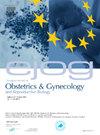Longitudinal changes of automated volumetric breast density with postmenopausal hormone therapy
IF 2.1
4区 医学
Q2 OBSTETRICS & GYNECOLOGY
European journal of obstetrics, gynecology, and reproductive biology
Pub Date : 2025-03-06
DOI:10.1016/j.ejogrb.2025.03.013
引用次数: 0
Abstract
Objective
To evaluate how volumetric percent density (VPD) changes longitudinally with postmenopausal hormone therapy (HT).
Study design
Medical records of 297 women who visited the outpatient clinic in a tertiary medical center between 2011 and 2019 were retrospectively reviewed. Study participants were postmenopausal hormone never-users (n = 103), estrogen therapy (ET) users (n = 95), and estrogen plus progestogen (EPT) users (n = 99). All hormone users were naïve to HT before the study. VPD was measured at least twice over 3 years, and was measured before and after HT in all hormone users. Longitudinal VPD changes were analyzed using a linear mixed effects model adjusted for age and body mass index (BMI) at index mammography.
Results
The mean age (standard deviation) of study participants at index mammography was 53.0 years (3.3 years). Baseline characteristics, including baseline VPD, were similar across the three groups. After adjustment for age and BMI, the predicted slopes of annual VPD change did not differ among never-users, ET users, and EPT users (−6.8 % (95 % CI −12.1 % to −1.6 %), 0.2 % (95 % CI −4.4 % to 4.8 %), and 0.4 % (95 % CI −5.1 % to 4.3 %), respectively (P = 0.21)). Furthermore, subgroup analyses stratified by estrogen formulation did not demonstrate any difference in the slopes of annual VPD change among never-users, conjugated equine estrogen users, estradiol valerate users, and EPT users (−7.0 %, −1.2 %, 4.9 %, and −0.5 %, respectively; P = 0.27).
Conclusion
The predicted annual VPD change did not differ by HT during 3 years of follow-up. Neither ET nor EPT increased VPD.
求助全文
约1分钟内获得全文
求助全文
来源期刊
CiteScore
4.60
自引率
3.80%
发文量
898
审稿时长
8.3 weeks
期刊介绍:
The European Journal of Obstetrics & Gynecology and Reproductive Biology is the leading general clinical journal covering the continent. It publishes peer reviewed original research articles, as well as a wide range of news, book reviews, biographical, historical and educational articles and a lively correspondence section. Fields covered include obstetrics, prenatal diagnosis, maternal-fetal medicine, perinatology, general gynecology, gynecologic oncology, uro-gynecology, reproductive medicine, infertility, reproductive endocrinology, sexual medicine and reproductive ethics. The European Journal of Obstetrics & Gynecology and Reproductive Biology provides a forum for scientific and clinical professional communication in obstetrics and gynecology throughout Europe and the world.

 求助内容:
求助内容: 应助结果提醒方式:
应助结果提醒方式:


